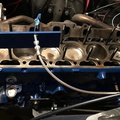Not a problem.
First it looked like the locator was part of and the same material as the guide.
Then your machinist verified that the locator is steel and the guide is bronze so they can't be one piece which means the steel locator was pressed on to the guide.
Then I called the company that will be doing future production for Matt and even though they haven't done any heads yet they felt that the locator was just a press on item.
First it looked like the locator was part of and the same material as the guide.
Then your machinist verified that the locator is steel and the guide is bronze so they can't be one piece which means the steel locator was pressed on to the guide.
Then I called the company that will be doing future production for Matt and even though they haven't done any heads yet they felt that the locator was just a press on item.











 I have to say this has really been a great discussion with Bob and everyone on his 250 upgrades.
I have to say this has really been a great discussion with Bob and everyone on his 250 upgrades.